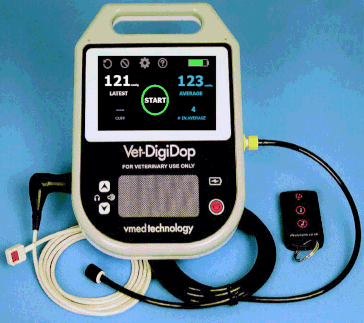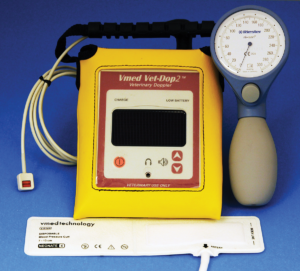Vmed Blood Pressure Monitors
Vet-DigiDop |
Vet-Dop2 |
BP-AccuGard |
Vet-Tab BP |
 |
 |
 |
 |
The new Vet-DigiDop reduces Doppler measurement time and improves accuracy.
Save time and increase accuracy!
• Simply press a button to measure systolic pressure
• See current pressure and running average
• Reject questionable measurements
• Automatic averaging
• Silent or audio alarms for surgery
Features
• Sensitive 9.6 MHz Doppler probe
• Color touch screen
• Settings menu with troubleshooting and instructions
• Set of five animal cuffs with size gauge
• Stereo audio headphones
• 8′ airline
• Charger for 100-240 Volts, 50/60 Hz
• Storage pouch
• Wireless remote mark switch
Testimonial
I have really enjoyed using the Digi-Dop in all aspects of the hospital. It has made taking blood pressures during surgery an easier process, and our surgery team quickly mastered making it a part of their regular monitoring. The probe is much sturdier than our traditional Doppler probes and, according to my support staff, easier to use. This has helped me feel comfortable delegating the task of taking blood pressures more, and the Digi-Dop’s digital nature helps me trust the results they are bringing back to me. I have used it in the room with multiple clients, and they have really gotten into the process in a different way than the traditional sphygmomanometer allows. One of my clients even mentioned how much fun it was to measure her dog’s blood pressure.
Emily
Dr. Emily Johnson
Owner/Veterinarian
Dutch Fork Animal Hospital
1780 Dutch Fork Road
Irmo, SC 29063
(803) 781-7483 – Phone
(803) 781-7462 – Fax
Small Animal Blood Pressure. See “Products” for description of all our BP products.
While direct invasive measurement of blood pressure is most accurate it is not practical in diagnosis and expensive and time consuming in surgery. Non-invasive animal blood pressure is a difficult proposition due to the relative size of the blood vessels, ample hair and fur and generally uncooperative patients. For years Doppler was the only viable method to obtain blood pressure in small animals although the method entails manual cuff inflation, reading the pressure gauge accurately and is dependent on the skill of the user. Oscillometric devices designed for humans have been sold for veterinary use with poor results. Our new BP-AccuGard oscillometric blood pressure monitor overcomes many of the deficiencies found in Doppler and earlier automatic devices. Motion tolerant and small animal validated software insures quick, accurate results every time even in patients as small as 1.5 Kg. The time to calculate a pressure is between 10 and 30 seconds depending on the patient size and movement. To ensure accuracy the calculation restarts if there is excessive movement which at times results in a calculation time over 30 seconds. While longer calculation times are a disadvantage for diagnostic evaluations on the awake animal, accuracy is always assured and proper patient preparation and handling will allow timely calculations. Doppler is still a viable choice because a skilled user may be able to get quicker results in many cases although only systolic pressures are available.
Blood Pressure in Veterinary Medicine
In a recent study, 61% of cats and 93% of dogs with chronic renal failure also had systemic hypertension. Also, 87% of cats with untreated hyperthyroidism had systemic hypertension. Cushing diseased dogs should be checked for hypertension. All geriatric pets should also be routinely checked for hypertension. “It is almost mandatory that every veterinary practice have the capabilities for blood pressure screening and monitoring. On a practical level, every veterinary practice should have a blood pressure unit, especially in feline medicine. Numerous studies in the veterinary literature show that a large percentage of cats more than 12 years of age have hypertension, either secondary to chronic renal disease or from underlying thyroid disease. A blood pressure monitoring device is critical for practitioners who see a large number of geriatric feline patients. Blood pressure should be recorded for cats with left ventricular hypertrophy of an unknown cause, cats with renal disease, cats with acute visual problems, and other critically ill patients. Diseases commonly associated with hypertension in both the dog and cat, include systemic hypertension and renal disease, hyperadrenocorticism, hyperthyroidism, essential of primary hypertension, and pheochromocytoma. Of these, Cushing’s disease, (dogs) and renal disease are probably the most common. The majority of cats diagnosed as hypertensive are presented to veterinarians for the evaluation of ocular abnormalities such as dilated pupils, hyphema or presumed blindness. It is important to realize that “normal” is going to depend on technique and the status of the patient. It is best to take 5 to 6 recordings and to eliminate the upper and lower values and average the remaining values. A systolic blood pressure is elevated in an unstressed, awake, dog or cat if it is consistently greater than 170-180 mmHg in the cat, or greater than 180 mmHg in the dog”.
Systemic Hypertension: Diagnosis & Treatment, Larry P. Tilley, DVM, DACVIM (Internal Medicine)


